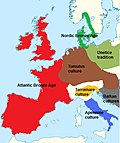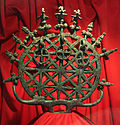 | Cycladic culture (also known as Cycladic civilisation or, chronologically, as Cycladic chronology) was a Bronze Age culture (c. 3100–c. 1000 BC) found... 14 KB (1,538 words) - 13:54, 29 April 2024 |
 | Cycladic art The ancient Cycladic culture flourished in the islands of the Aegean Sea from c. 3300 to 1100 BCE. Along with the Minoan civilization and... 21 KB (2,465 words) - 22:14, 12 March 2024 |
3rd millennium BC (section Cultures) c. 3000 BC: Nubian A-Group Culture comes to an end. c. 2300 BC: Nubian C-Group culture. Europe c. 3200 BC: Cycladic culture in Aegean islands of Greece... 20 KB (2,365 words) - 08:09, 5 March 2024 |
 | The Hallstatt culture was the predominant Western and Central European archaeological culture of the Late Bronze Age (Hallstatt A, Hallstatt B) from the... 76 KB (8,518 words) - 22:15, 5 May 2024 |
 | Naxos (section Cycladic civilisation) and the largest of the Cyclades. It was the centre of the archaic Cycladic culture. The island is famous as a source of emery, a rock rich in corundum... 25 KB (2,242 words) - 04:00, 3 May 2024 |
 | Kurgan hypothesis (redirect from Kurgan culture) prehistoric cultures, including the Yamnaya (or Pit Grave) culture and its predecessors. In the 2000s, David Anthony instead used the core Yamnaya culture and... 34 KB (3,825 words) - 14:41, 30 April 2024 |
 | Indus Valley Civilisation (redirect from Indus Valley Culture) and later cultures called Early Harappan and Late Harappan in the same area. The early Harappan cultures were populated from Neolithic cultures, the earliest... 187 KB (21,239 words) - 12:48, 7 May 2024 |
 | Minoan civilization (redirect from Minoan culture) other contemporary cultures and later Ancient Greek art has been much discussed. It clearly dominated Mycenaean art and Cycladic art of the same periods... 114 KB (13,577 words) - 04:15, 28 April 2024 |
 | The Apennine culture is a technology complex in central and southern Italy from the Italian Middle Bronze Age (15th–14th centuries BC). In the mid-20th... 10 KB (1,174 words) - 08:41, 18 March 2024 |
 | The Tumulus culture (German: Hügelgräberkultur) was the dominant material culture in Central Europe during the Middle Bronze Age (c. 1600 to 1300 BC)... 24 KB (2,074 words) - 10:23, 25 April 2024 |
 | The Ulaanzuukh culture, also Ulaanzuukh-Tevsh culture (Ch:乌兰朱和文化, c. 1450-1000 BCE), is an archaeological culture of the Late Bronze Age eastern Mongolia... 11 KB (1,186 words) - 13:34, 5 May 2024 |
 | The Abashevo culture (Russian: Абашевская культура, romanized: Abashevskaya kul'tura) is a late Middle Bronze Age archaeological culture, ca. 2200–1850... 25 KB (2,936 words) - 17:15, 15 April 2024 |
 | Maykop culture (Russian: майкоп, [mɐjˈkop], scientific transliteration: Majkop,), c. 3700 BC–3000 BC, is a major Bronze Age archaeological culture in the... 22 KB (2,637 words) - 10:03, 11 April 2024 |
Okunev culture (ru: Окуневская культура, romanized: Okunevskaya kul'tura, lit. 'Okunev culture'), sometimes also Okunevo culture, was a south Siberian... 54 KB (5,767 words) - 08:15, 1 March 2024 |
copper with arsenic); as did the first significant Aegean group: the Cycladic culture after c. 2800 BC. In the North, the supposedly Indo-European groups... 14 KB (1,770 words) - 13:26, 2 May 2024 |
 | The Andronovo culture is a collection of similar local Late Bronze Age cultures that flourished c. 2000–1150 BC, spanning from the southern Urals to the... 63 KB (7,041 words) - 15:09, 4 May 2024 |














